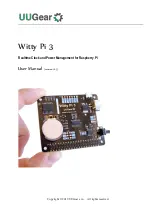
3.2.1.16 XT Zone Interlock Off (Blink Code 2-9)
-This function turns off XT Zone Interlock (see 3.2.1.15) and allows the 3598
StreamMaster XT monitor to freely move into the extra travel zone (+90 to +120 degrees). This function only applies to the 3598
StreamMaster XT monitor.
3.2.1.17 Electric Riser Off (Blink Code 3-1)
– This function disables the electric riser (Style 3406) when used with the 3440
DeckMaster monitor. This is the factory default setting. This function only applies to the 3440 DeckMaster monitors, both with
and without the position feedback option. When off, the electric riser will not move during the stow or deploy sequence.
3.2.1.18 Electric Riser On (Blink Code 3-2)
– This function enables the electric riser (Style 3406) when used with the 3440
DeckMaster monitor. When on, during deploy, the electric riser will lift the monitor up and then the monitor will deploy. During
stow, the monitor will stow and then the electric riser will retract.
3.2.2 Stow (Blink code 1-5)
To enter the Stow programming mode, momentarily press the Stow switch when in the beginning
of setup mode (1 slow blink). To verify you are in the Stow programming mode, verify that the Panel LED is blinking a pattern
of one short blink, a short pause, then five short blinks, and a long pause. While in this mode, Up, Down, Left, and Right
functions will be active. Movement will not be constrained by soft limits, allowing a stow position that is outside the
normal operational envelope. However, obstacle avoidance will be disregarded while learning the stow position, so care
must be taken to avoid obstacles manually while learning the stow position. When in the desired stow position, there are two
methods of completion. Activating the Fog command will save the position and cause the nozzle to go to the fog setting
during the stow sequence, and return the user to the beginning of the setup mode. Activating the Stream command
will save
the position and cause the nozzle to go to the stream setting during the stow sequence, and return the
user to the beginning
of setup mode. This mode may be aborted by activating the Stow input again which will return
the user to the beginning of
setup mode. The factory default stow position is “straight ahead and level” as defined
by the sensor zeroing
(see section 3.2.1.6).
3.2.3 Deploy
(Blink code 1-6)
To enter the Deploy programming mode, momentarily press the Deploy switch when in the beginning of setup mode (1 slow
blink). To verify you are in the Deploy programming mode, verify that the Panel LED is blinking a pattern of one short blink, a short
pause, six short blinks, and a long pause. While in this mode, Up, Down, Left, and Right functions will be active. Movement will be
constrained to whatever soft limits that are in effect. However, obstacle avoidance will be disregarded while learning the deploy
position, so care must be taken to avoid obstacles manually while learning the deploy position. When in the desired deploy
position, there are two methods of completion. Activating the Fog command will save the position and cause the nozzle to go
to the fog settingduring the deploy sequence, and return the user to the beginning of the setup mode. Activating the Stream
command will save the position and cause the nozzle to go to the stream setting during the deploy sequence, and return the user
to the beginning of setup mode. This mode may be aborted by activating the Deploy input again which will return the user to the
beginning of setup mode. The factory default deploy position is “straight ahead and level” as defined by the sensor zeroing (see
section 3.2.1.6).
3.3 DESCRIPTION OF SWITCH FUNCTIONS
The Universal II has nine switch inputs located on the vehicle connector (see Figure 2 3 and Table 2 3). Below are the various
functions that the Universal II switch inputs can provide. Each variant of 6032 will have some combination of these, but not
necessarily all or in the order presented here. These inputs are typically driven by variants of the style
6041 Toggle switch Operator Station.
NOTE: The Universal II switch inputs are three-state inputs. Refer to section 2.5.6 for additional information and proper wiring.
3.3.1 Enable Switch (J1 Pin 13)
This switch input functionality is provided across the full line of 6032 variants. It provides capability for interlocking operation of
the monitor/turret with the state of condition(s) outside the system for safety purposes. Examples might be a parking brake set,
a lighting mast retracted, or a roof ladder deployed. This input must not be left “floating” or disconnected if the monitor/turret
is to operate. Connection to Battery or -Battery (usually ground) by switch, hardwiring, or some other appropriate device
will enable monitor operation.
23
















































